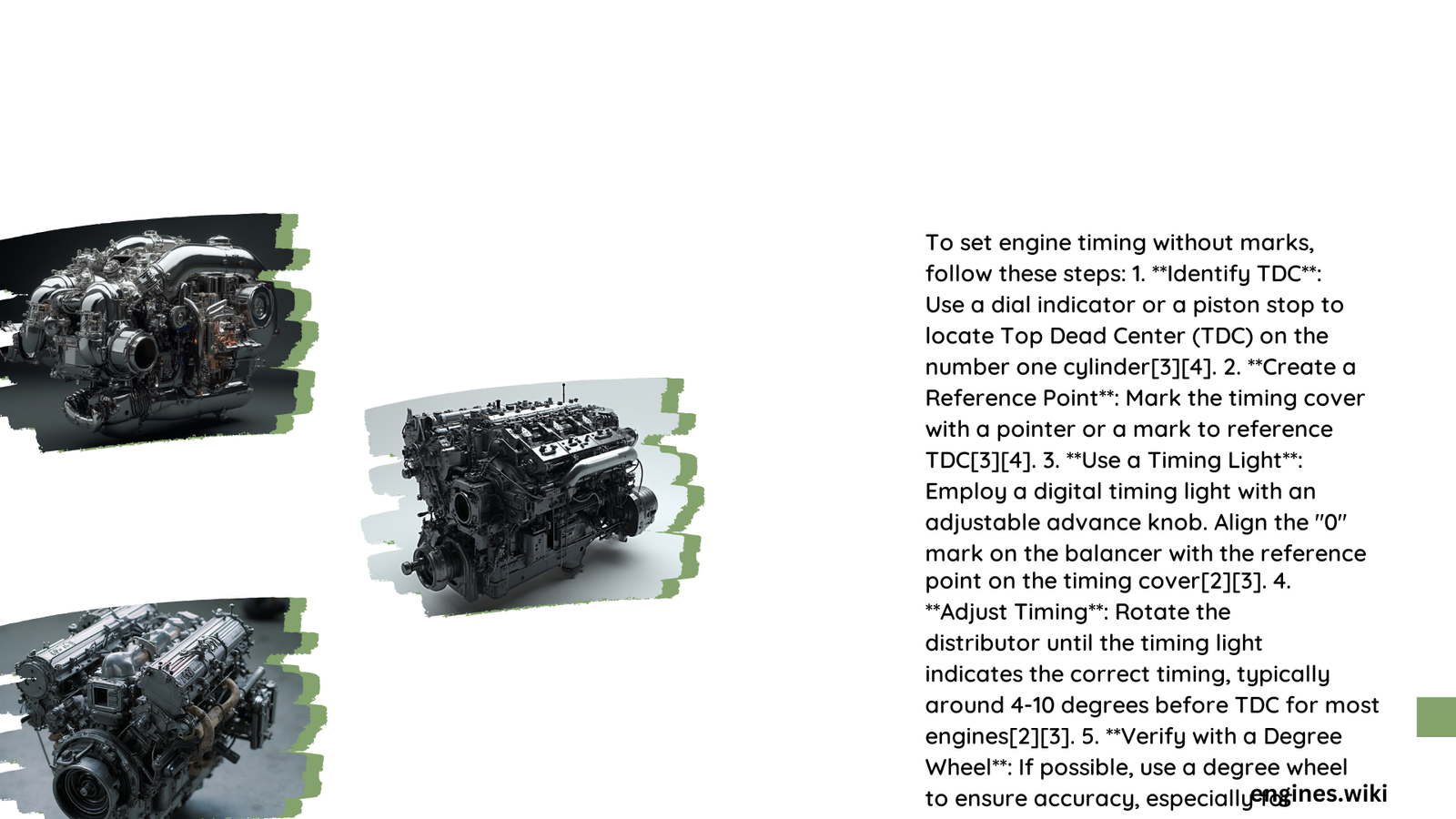Engine timing without marks presents a complex challenge for automotive technicians and enthusiasts. Precise timing adjustment requires specialized techniques and comprehensive understanding of engine mechanics. Mechanics must employ alternative methods like compression detection, manual positioning, and advanced diagnostic tools to accurately set engine timing when traditional visual markers are absent.\n\n## What Are the Essential Tools for Engine Timing Without Marks?\n\n### Required Equipment\n\n| Tool | Purpose | Estimated Cost |\n|——|———|—————-|\n| Compression Gauge | Verify Piston Position | $20-$50 |\n| Socket Wrench Set | Rotate Crankshaft | $50-$150 |\n| Vacuum Gauge | Fine-Tune Timing | $30-$80 |\n| Timing Light | Verify Advance Settings | $50-$200 |\n\n### Detailed Procedure for Timing Adjustment\n\n#### Determine Top Dead Center (TDC)\n\n1. Manual Rotation Technique\n – Use socket wrench to rotate engine clockwise\n – Feel for compression stroke resistance\n – Identify number one piston’s peak position\n\n2. Compression Verification\n – Connect compression gauge to cylinder\n – Observe peak pressure point\n – Confirm precise piston positioning\n\n#### Creating Custom Timing Marks\n\n- Use permanent marker or specialized timing tape\n- Create reference points on crankshaft and timing cover\n- Ensure consistent, clear markings\n\n### Advanced Diagnostic Methods\n\n#### Vacuum Gauge Optimization\n\nThe vacuum gauge method provides nuanced timing adjustment:\n\n- Disconnect distributor vacuum line\n- Connect gauge to intake manifold\n- Adjust distributor position\n- Identify optimal vacuum pressure point\n\n### Potential Challenges and Solutions\n\nCommon Issues:\n- Lack of manufacturer reference marks\n- Complex engine configurations\n- Limited access to timing components\n\nRecommended Solutions:\n- Utilize digital diagnostic tools\n- Consult vehicle-specific technical manuals\n- Seek professional diagnostic assistance\n\n### Performance Implications\n\nPrecise timing adjustment directly impacts:\n- Engine efficiency\n- Fuel consumption\n- Power output\n- Emissions control\n\n## What Are the Risks of Incorrect Timing?\n\n- Potential Engine Damage\n – Premature wear\n – Reduced performance\n – Increased maintenance costs\n\n- Performance Degradation\n – Reduced horsepower\n – Inconsistent acceleration\n – Higher fuel consumption\n\n### Expert Recommendations\n\n1. Always use manufacturer specifications\n2. Invest in high-quality diagnostic equipment\n3. Perform timing adjustments systematically\n4. Verify results through multiple measurement techniques\n\n## Conclusion\n\nEngine timing without marks requires technical expertise, precision tools, and methodical approach. Professionals must combine mechanical knowledge with advanced diagnostic techniques to achieve optimal engine performance.\n\n### Reference:\n- Professional Automotive Diagnostics Guide\n- Advanced Engine Timing Techniques

